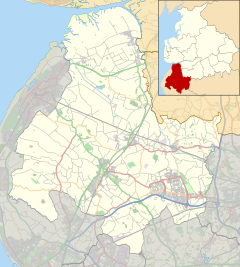Lathom House
| Lathom House | |
|---|---|

Lathom House c. 1880
|
|
|
Location within the Borough of West Lancashire
|
|
| General information | |
| Type | Country house |
| Architectural style | Palladian |
| Location | Lathom, Lancashire |
| Country | England |
| Coordinates | 53°34′33″N 2°49′01″W / 53.5758°N 2.8170°WCoordinates: 53°34′33″N 2°49′01″W / 53.5758°N 2.8170°W |
| Construction started | 1725 |
| Completed | 1740 |
| Demolished | 1925 (main block) |
Lathom House was a large country house at Lathom in Lancashire, England. The main building was demolished in 1925.
A wooden castle is believed to have stood on the site in mediaeval times.
The stone-built castle known as Lathom House, built by the Stanley family in 1496, had eighteen towers, and was surrounded by a wall six foot thick and a moat eight yards wide, its drawbridge defended by a gateway tower. In the centre of the site was a tall tower known as the Eagle Tower.
In 1554, Protestant martyr George Marsh, was questioned at Lathom House by Edward Stanley before being sent to Lancaster Castle.
Lathom House was the last Royalist stronghold in Lancashire during the English Civil War and was twice besieged by Parliamentarian forces. During the first Siege of Lathom House by Sir Thomas Fairfax in 1644, the house was defended by Charlotte Stanley, Countess of Derby and 300 men who kept possession until Royalist forces under Prince Rupert of the Rhine arrived in the area en route to attack Bolton. After the siege the countess and her retinue fled to the Isle of Man. In 1645 the house was again besieged by General Egerton with 4000 Parliamentarian soldiers, and was surrendered after a protracted siege after which the fortifications were demolished by the Parliamentarians.James Stanley, husband of Charlotte, was beheaded in Bolton by the Parliamentarians in 1651 for treason. The Stanley manors were confiscated by Parliament.
...
Wikipedia

